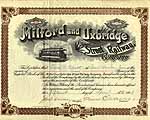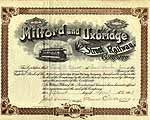| Rarity: |
It seems counter intuitive, but rarity might be the most subjective all the criteria when dealing with stocks. Its clear that large numbers of certificates still remain undiscovered. So, as a collector, I've tried to measure rarity as a function of how difficult it would be to find the piece for sale if went looking for it online, or at a live Scripophily show.
| Ranking | Meaning |
|---|
| 1-3 |
Found on demand. Easily found at online auctions. Many larger dealers will have in stock.
|
| 4-6 |
Good supply. Will show up regularly online. Some hunting may be required but at least a couple of larger dealers should have it in stock.
|
| 7 |
Limited supply. Will show up only occassionally online. Probably not in stock with more than 1 or 2 large dealers. Hard to find.
|
| 8 |
Short supply. Very Hard to find. Rarely if ever offered online. Will not be found in dealer inventory on a regular basis.
|
| 9 |
No supply. Very few exist. Turnover limited to broken up collections. Very few opportunities to own one.
|
| 10 |
True rarity. You may have only a couple of chances to purchase per decade, or in some cases, per life time.
|
|
|---|
| Industry: |
The value of a stock or bond can be greatly influenced, and is often established, based on the industry of the company represented. The most obvious reason is simply the number of collectors specializing in an industry has a dramatic impact on the demand for stocks in that industry. The are many Railroad company stock collectors but not many Shoe Company collectors.
| Ranking | Meaning |
|---|
| 1-3 |
Few Collectors concentrate on industries ranked here. Some examples might include "Real Estate", "Agriculture" and "Manufacturing" related issues.
|
| 4-6 |
Some collectors. A varied number of collectors actively seek these issues because of their industry. Cotton Mills, Watch producers, Electric utilities all qualify in this range.
|
| 7 |
Many Collectors. Industries such as shipping, boat building, oil and banking all have strong collector interest.
|
| 8 |
Aviation along with automobile and gun manufacturers are good examples of a level 8 ranking. Very specialized collectors quickly gobble up new material when it hits the market.
|
| 9 |
A few industries, link Mining and Railroads, have very large numbers of collectors. These industries also have many specialties within them.
|
| 10 |
Some unique industries will get a great deal of attention from general collectors. Air-ships (blimps) and whaling related stocks may be good examples.
|
|
|---|
| Beauty: |
The more attractive a certificate's design, the more interesting it is to collectors. Most everyone likes to display their better looking pieces. Some certificates are so ornate that they're considered true works of art.
| Ranking | Meaning |
|---|
| 1 |
Handwritten or printed certificates without fancy scrips, borders or vignettes.
|
| 2 |
Printed certificates with only mildly fancy scrips and perhaps a single fancy border.
|
| 3 |
An all around fancy border or very fancy scrips. Still no vignette.
|
| 4-6 |
Borders and vignettes. Usually not that elaborate. Standard pre-printed forms sold to multiple companies who just add their name will usually be classified in this range.
|
| 7 |
Usually custom certificates with pleasing images, most often engraved with fancy but common images.
|
| 8 |
Very ornate certificates, lithographed or engraved. Uncommon images. Certificates that display a companies product will usually fall into this group. Very farmable.
|
| 9 |
Very fancy and unique looking certificates that will impress collectors and non collectors alike. Suitable to replace prints, paintings or other artwork in any office.
|
| 10 |
Best of the best.
|
|
|---|
| Cross-Collectable: |
Many certificates appeal to collectors of other things besides stock certificates. Railroad stocks are the most obvious example. Almost all the model railroaders I know have at least 1 stock or bond displayed in the room where they play with their trains. A status of 1 indicates the certificate has little value outside of scripophily circles and a 10 indicates outside interest is huge. Another type of often overlooked cross-collectability deals is based on town where the represented company was located. People from smaller towns, especially those towns with important industrial histories, will collect many forms of memorabilia from that town. Online auctions allow them to find items such as stock certificates when they search by town name. This can greatly improve the value of stock certificates from popular locations.
|
|---|
| Importance: |
More correctly describe as Historical Importance. The historical importance of a certificate may come from it being issued to or signed by a famous person. Or it could be the company itself that had an significant impact on society. Either way, many serious collectors will only be interested in a certificate for its importance. Again there is no need for a breakdown. Its a very subjective assignment on my part.
|
|---|
| Age: |
Age plays a huge part in determining the value and desirability of a stock or bond. The breakdown below represents a starting point. It will be adjusted for specific industries. For example, a Helicopter stock from the 1940's would have to be considered old, and would not be listed at a ranking of "2".
| Ranking | Meaning |
|---|
| 1 |
1950 - Present.
|
| 2 |
1930 - 1949.
|
| 3 |
1920-1929.
|
| 4 |
1900-1919.
|
| 5 |
1880-1899.
|
| 6 |
1870-1879.
|
| 7 |
1860-1869.
|
| 8 |
1840-1859.
|
| 9 |
1830-1839.
|
| 10 |
Pre 1830.
|
|
|---|
| Overall Value: |
Here I make my best guess as to the overall value of an item by balancing its rarity (supply) against the other factors list above (demand). I don't try to establish actual retail values or traditional catalog values. Instead, this ranking simply provides my opinion, again on a scale of 1 to 10, of the fair value of each item, in relation to other certificates. You should expect to pay more for a 7 than a 5, and so on.
|
|---|



